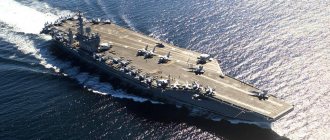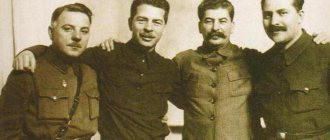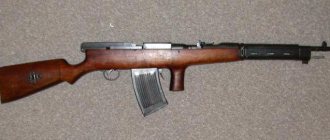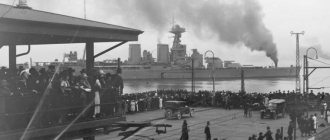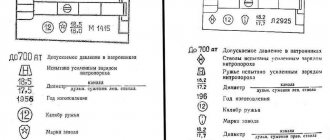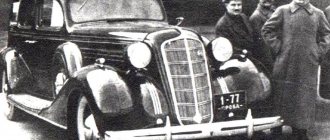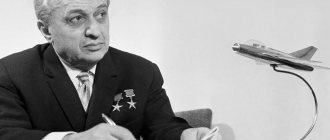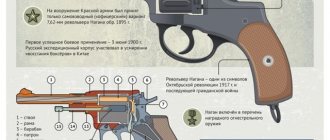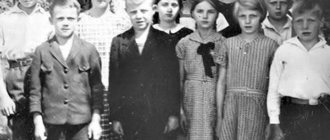Childhood and youth
Heinz Guderian was born in 1888. He was born in the town of Kulm. At that time it was located on the territory of Prussia, now it is the settlement of Chelmno in Poland.
You might be interested in: “Temporary” or “temporary”: which is correct? Difference between words
Heinz Guderian's father was a career officer, which affected the career of the hero of our article. His ancestors were landowners who owned land in the Warta region. Mother, Clara Kirgoff, was a hereditary lawyer.
In 1890, Heinz Guderian gave birth to a brother named Fritz. In 1901, both of them were accepted into the cadet corps for young children. In 1903, Heinz was transferred to a building for older children, and he left for the outskirts of Berlin. In 1907, having successfully passed all the necessary exams, he received a certificate of maturity.
Early career
You may be interested in: The meaning and significance of the word “avant-garde”
After studying in the cadet corps, Heinz Wilhelm Guderian, as the full name of the future officer sounds, entered military service in the Jaeger battalion in Hanover. This takes place in 1907. At that time, it was his father who commanded him.
After a 6-month course at a military school, at the beginning of 1908 he was promoted to the rank of lieutenant. Then Guderian served in the telegraph battalion for about a year, and after that in the military academy located in Berlin.
During the war
When World War I began, Heinz Wilhelm Guderian was appointed head of the heavy radio station in the Fifth Cavalry Division.
In 1915 he became an auxiliary officer in the cipher service under the command of the Fourth Army. In November 1916 he received the Iron Cross, First Class, for diligent service.
You may be interested in: Interesting facts about the Black Sea that we didn’t know.
The following year he was transferred to the Fourth Infantry Division, and from there to the headquarters of the First Army. Since February 1918, Heinz Guderian, whose photo you will find in this article, has served on the General Staff. The command highly values his proposals, so by the end of the war he even heads the operational department in the occupied Italian territories.
In addition to the Iron Crosses, he also received the Knight's Cross, an Austrian commemorative war medal, during the First World War.
Peaceful time
Having suffered defeat, the German army is in a catastrophic situation. Guderian manages to continue serving in the Reichswehr. This is now the name of the German army, limited in size and composition under the terms of the Treaty of Versailles
Guderian heads the Jaeger battalion and commands the 20th Infantry Regiment. Since 1922 he has served in Munich on a permanent basis. In April, he was appointed inspector of motor transport at the War Ministry. By 1928, Guderian was already a tactics instructor at headquarters in Berlin.
His record also includes command of a motor transport battalion and leadership of the headquarters of motor transport troops. In the summer of 1932, Guderian came to the Soviet Union, to the Kama tank school, located in the Kazan region. In the USSR he is with his immediate superior, General Lutz.
In 1934, Heinz headed the headquarters of the motorized troops, and in 1935 - already the tank forces. He convinces everyone around him that in the future, the military successes of any army will directly depend on how successfully it can use the potential of tank forces.
In September 1935, Guderian became commander of the Second Panzer Division, which was permanently stationed in the Würzburg area.
After signing the settlement agreement
When the First World War ended, Guderian remained in the service of the Reichswehr, and after that he was transferred to the headquarters of the Iron Division, located in Latvia.
He was a company commander in a Jaeger battalion and led military units of the 20th Infantry Regiment. In 1922 he was transferred to Munich, where he served in a motor transport battalion.
Two years later, the hero of our article became an instructor at the non-commissioned officer school in the infantry division based in Stettin, and was an instructor at the Berlin motor transport headquarters, responsible for combat tactics. In the summer of 1932, Guderian came to the USSR to a tank school called Kama, which was based in Tatarstan. They carried out an inspection with General Lutz. At the same time, the hero of our article himself did not undergo any training in Kazan.
Obsession with tanks
Of all the vehicles that can be used during the war, Guderian relies on tanks.
In 1937, he even published his own book entitled “Attention, Tanks! History of the creation of tank forces." In it, he describes in detail and in every detail how tank troops appeared, what are the most effective ways to use them.
In February 1938, Heinz Guderian, whose biography is described in this material, became commander of the German tank forces. He establishes his headquarters on the basis of the 16th Motorized Corps. Becomes a commander with the rank of lieutenant general.
Division commanders
Colonel, Major General (1.8.36) Heinz Guderian – 10/15/1935 – 01/31/1938 Major General, Lieutenant General (10/1/39) Rudolf Veiel – 02/1/1938 – 02/16/1942 Major General Baron Hans-Karl von Esebeck – 17.02 – 31.05.1942 (went on leave) Major General Arno von Lenski – 1-30.06.1942, acted as Major General Baron Hans-Karl von Esebeck – 1.07 – 9.08.1942 (wounded) Colonel Vollrath Lübbe – 10-28.08.1942 (ill) Colonel Karl Fabiunke – 29.08 – 4.09. 1942, acted as Major General, Lieutenant General (1.04.43) Vollrath Lübbe – 5.09.1942 – 31.01.1944 Lieutenant General Baron Heinrich von Lüttwitz – 1.02 – 4.05.1944 (left on leave) Lieutenant General Franz Westhoven - 05/5-26/1944, acting Lieutenant General Baron Heinrich von Lüttwitz - 05/27 - 08/31/1944 (wounded) Colonel Eberhard Graf von Noschtitz (Eberhard) von Nostitz) - 1-20.09.1944, acting colonel, major general (1.12.44) Henning Schönfeld - 21.09 - 14.12.1944 colonel, major general (1.03.45) Meinrad von Lauchert (Meinrad von Lauchert) Lauchert) - 12/15/1944 - 3/19/1945 Major General Oskar Munzel - 03/20 - 04/3/1945, acting as General Staff Major Waldemar von Gazen - 04/3-4/1945, acting as Colonel Karl Stolbrock (Karl Stollbrock) – 04.04 – 7.05.1945
Attack on Poland
You may be interested in: Her Majesty Queen Alexandra: biography, children, years of reign
As you know, World War II began with the invasion of German troops into Poland. Guderian takes a direct part in this, commanding the 19th Motorized Corps. For a successful operation, he was awarded the Iron Cross of the first degree, and a month later - the Knight's Cross.
The next step in the German command's plan was the invasion of France. Guderian carries it out at the head of the 19th Corps, which includes three tank divisions and a motorized infantry regiment, proudly called “Greater Germany”. These units are part of the army under the command of von Kleist, which carries out the main combat operations in France.
Organization[edit]
Unit organization: [2]
| 1939 - Poland | 1943 - Eastern Front |
|
|
|
|
|
|
| |
|
|
|
|
|
|
|
|
|
|
Tactics
In these battles, Guderian actively used blitzkrieg tactics, which he remained faithful to in most battles. At the same time, he carefully coordinates all his actions with the directives coming from the command. Moving forward with his tanks, Guderian causes significant devastation far beyond the expected front line, actively blocking the enemy's access to any communications, capturing entire headquarters.
So, for example, German troops manage to capture several French headquarters, in which officers believe that the Germans are on the western bank of the Meuse River, but in reality they have long since moved to the other side, depriving the French units of operational command and direct control.
During many of these operations, Guderian acted capriciously, earning himself a reputation as a poorly controlled commander from whom anything could be expected. In May 1940, at the height of the offensive operation, the commander of the group of forces, von Kleist, even temporarily removed Guderian from his immediate duties because he refused to obey a direct order. The incident is quickly resolved, and Heinz returns to his combat positions.
Following the results of the French campaign, his actions were recognized as successful, Guderian received the rank of Colonel General. In November 1940 he became commander of the Second Tank Group of Forces.
Working under Hitler
When Hitler came to power and established his dictatorship, the army was divided into two camps. Experienced officers came into conflict with the rising Nazi machine.
Guderian filled this gap. Despite his excuses, he became increasingly close to Hitler. Failed experiments with tanks in Ethiopia and Spain meant that despite his closeness to Hitler's regime, Guderian was playing a double game and trying to push his ideas to the top.
In 1938, Guderian commanded the XVI Corps, which took control of the Czech Republic. This success strengthened his enthusiasm for Hitler. Like most Germans, Guderian saw in Hitler a bringer of prosperity for Germany and a man capable of fighting the injustices of the Versailles Peace Treaty.
Guderian was put in charge of the XIX Corps, the deployment of tanks and motorized infantry, and the invasion of Poland. Having reached the front line, he perfectly maintained the morale of the soldiers, and they quickly moved forward. He was sensitive to vehicle malfunctions and forced the crew to respond quickly and correct them. Thanks to this service, Guderian learned a lot about his future. He proved that he was able to train and coordinate troops well.
Invasion of the USSR
It was at the head of the Second Panzer Group that Guderian invaded the territory of the USSR in the summer of 1941. The eastern campaign of Army Group Center involves the capture of the Brest region from two directions at once - from the north and south.
Blitzkrieg tactics on Soviet territory were a resounding success. Guderian operates by quickly breaking through enemy lines and then enveloping him with tank wedges. German troops are moving forward at a rapid pace. Minsk and Smolensk were captured. The Red Army on the Western Front in 1941 suffered a crushing defeat, largely due to Guderian's decisive actions. In July he already receives the Oak Leaves for the Knight's Cross.
Guderian did not pass: the heroic defense of Tula
Soviet 85-mm anti-aircraft gun model 1939 52-K of the 6th battery of the 732nd anti-aircraft artillery regiment on the Proletarsky Bridge in Tula
Enemy breakthrough
On September 30, 1941, the German army launched Operation Typhoon, an attack on Moscow.
In the southern sector, Guderian's 2nd Panzer Group (from October 5 - 2nd Tank Army) and Weichs' 2nd Field Army struck in the Oryol-Bryansk direction. The Nazis broke through the front of the Soviet Bryansk Front. Guderian's tanks quickly moved forward and captured Oryol on October 3. Three days later Karachev and Bryansk fell. The Bryansk Front was dissected, the divisions of the 3rd, 13th and 50th armies were surrounded. However, the German command paid increased attention to the breakthrough and did not attach much importance to the destruction of the Soviet armies caught in the cauldron. As a result, it was not possible to create a dense ring of encirclement; although the Soviet divisions suffered heavy losses, especially in materiel, they were able to reach their own. At the same time, the Soviet front actually collapsed at that time, and our command could not organize any unblocking strikes. The withdrawal of army directorates and remnants of troops allowed Headquarters to restore defenses in this sector with the involvement of reserves, divisions from the depths of the country and other sectors of the front, NKVD troops, schools, etc.
On October 7, 1941, Guderian received orders to continue the attack on Tula. Guderian's tanks were supposed to bypass Moscow from the southeast, and then from the east.
The Soviet Headquarters, in order to prevent the enemy from breaking through to Moscow in the southwest, decided to put forward its reserves so that they would delay the enemy until fresh forces arrived.
The newly formed 1st Guards Rifle Corps of General Dmitry Lelyushenko was thrown towards the enemy tank divisions. It included the 6th Guards Rifle Division, the 5th Airborne Corps, the 4th and 11th Tank Brigades, the Tula Weapons-Technical (Artillery) School, the 36th Motorcycle and 34th Border Regiments, two artillery regiment, two rocket artillery divisions and the 6th reserve air group. Lelyushenko's corps was supposed to close the road to Tula.
Lelyushenko immediately left for Mtsensk. At first, under his command there was only a motorcycle regiment and the Tula school, then Katukov’s 4th Tank Brigade arrived. Soviet tank crews launched a counter-attack on the enemy and even broke into Oryol. At this time the main forces of the corps arrived. Fierce fighting ensued.
Lelyushenko recalled:
“The soldiers of the 1st Special Guards Rifle Corps fought for nine days on the fields of the Oryol region. They changed the line four times, conducting a mobile defense, wearing out the enemy in fierce battles. At the fifth line on the Zusha River they stopped the enemy and held their positions until October 24.”
Then Lelyushenko's corps was included in the 50th Army.
Thus, Guderian's 2nd Panzer Army was detained in the Mtsensk area. The Germans were unable to take advantage of the defeat of the troops of the Bryansk Front and break through to Moscow along the shortest road Orel - Tula - Moscow, Bryansk - Moscow.
By October 23, the armies of the Bryansk Front, including the 50th, having suffered heavy losses, reached their own. The 50th Army of General Ermakov again entered the battle, covering the line on the Oka River in the Belev area, closing the road to Tula. The army was reinforced by units of the Tula combat sector - a military school, a workers' regiment and the 14th reserve rifle brigade.
Tanks Pz.Kpfw. III 35th Tank Regiment of the Wehrmacht with troops and artillery observers in armored vehicles Sd. Kfz.250 moving along the Mtsensk – Tula road
The city's defenders are ready for battle. Tula, intersection of Sovetskaya and Kommunarov streets
Defense of Tula
On October 24, 1941, the battle for Tula began.
From the beginning of the battle for Moscow, Tula began to be prepared for defense. The approaches to the city were covered with anti-tank ditches, wire fences were erected, sections of roads were mined, anti-tank hedgehogs and gouges were placed in the streets, and barricades were erected. Local residents actively participated in the construction of defensive structures. Three defensive lines were created around Tula. At the same time, factories and enterprises, primarily military ones, were evacuated.
An important role in the defense of Tula was played by the City Defense Committee created on October 22, which was headed by the first secretary of the regional party committee Vasily Zhavoronkov. It also included N. I. Chmutov, chairman of the regional executive committee, V. N. Sukhodolsky, head of the regional department of the NKVD, and Colonel A. K. Melnikov (commander of the 69th brigade of the NKVD troops for the protection of especially important industrial enterprises, the brigade fought on the outskirts of Tula and Stalinogorsk) - commandant of the city. The city committee roused the people to fight the enemy. The Tula Workers' Regiment (1,500 fighters) is formed from the destroyer battalions.
Members of the Tula City Defense Committee: N. I. Chmutov, V. G. Zhavoronkov (chairman), A. K. Melnikov, V. N. Sukhodolsky
The 50th Army, replenished with new forces, put up stubborn resistance to Guderian's army. On October 30, the 217th, 290th, 154th, 173rd and 260th rifle divisions were included in the Tula combat sector. It was headed by the deputy commander of the 50th Army, Major General V.S. Popov.
Under pressure from superior enemy forces, the troops of the 50th Army retreated to Tula. The neighboring 3rd Army was retreating east, to Efremov.
German mobile units, advancing from the Mtsensk area, reached Tula directly on October 29. The Nazis captured Yasnaya Polyana, a metallurgical plant, the village of Kosaya Gora, and Ivanovskie Dachas. The Germans had a serious advantage in manpower and equipment (two tank divisions) and planned to take the city on the move.
Fierce fighting raged for three days. Our troops repelled one attack after another. So, from October 30 to November 1, 38 German tanks were knocked out. Despite the fact that only part of the troops of the 50th Army retreated to Tula, it, together with the Tula garrison (156th NKVD regiment of Major S.F. Zubkov, 732nd anti-aircraft artillery air defense regiment of Lieutenant Colonel M.T. Bondarenko, workers' regiment Major A.P. Gorshkov), relying on anti-tank defense, defended the city until reinforcements arrived.
Barricades on Kommunarov Street in Tula
Barricades on Krasnoarmeyskaya Street in Tula
Guderian stopped
In November 1941, the German High Command decided to continue the offensive and “finish off Moscow.”
The German Headquarters was going to dismember the Russian front defending the capital, surround Moscow from the north and south, and capture it. The Nazis hoped that the Russian forces were already exhausted, and Moscow would fall under the decisive blows of the Wehrmacht. Guderian's 2nd Army was reinforced with two army corps and replenished with tanks. The Germans still had the advantage in manpower, artillery and tanks. And in the directions of the main attacks, where mobile formations were advancing, the Nazis had a 6-7 fold advantage. The 2nd Tank Army launched attacks on Tula, Stalinogorsk and Kashira. The offensive was supported by the 2nd Field Army. The right flank of Kluge's 4th Field Army, which was preparing an attack on Serpukhov, was drawn into heavy protracted battles with General Belov's cavalry-mechanized group, which, with the support of Zakharkin's 49th Army, launched a counterattack on the enemy.
On November 18, Guderian launched the main forces of his army into an attack, bypassing Tula from the southeast, breaking through to Kolomna and Kashira, and then to Moscow. Having broken through the defenses of the 50th Army, the Nazis occupied the Bolokhovo-Dedilovo area.
On November 21, German tanks occupied the Uzlovaya and Stalinogorsk areas, and on the 26th they broke into Mikhailov and Serebryanye Prudy. The Germans reached the immediate approaches to Kashira, cut the railway and the Tula-Moscow highway north of Tula. However, the Nazis were unable to break through further.
Belov's cavalry corps was urgently turned to the Kashira area, which, together with the 112th Tank Division and other troops, launched a counterattack on the enemy on November 27–30. Guderian's troops were thrown back 10–15 km south of Kashira to Mordves.
Guderian regrouped his troops and on December 2 tried to break through bypassing Tula from the northeast and east, encircling the divisions of the 50th Army and taking the stubborn city. At the same time, the Nazis attacked north of Tula from the west. The Nazis advanced several kilometers, but were unable to break through the defenses of the Soviet troops.
The troops of the 50th Army, which was headed by General Boldin on November 22, repelled the enemy attack. Our troops restored connections between Tula and Moscow. At this time, the reserve 10th Army was deployed in the Ryazan region.
The German army was drained of blood and could no longer advance. Guderian began the withdrawal of troops from the ledge formed northeast of Tula.
Thus, the path for the Nazis to Moscow from the south was completely closed.
Crew of the 85-mm anti-aircraft gun 52-K of the 6th battery of the 732nd anti-aircraft artillery regiment on the defense lines
Damaged half-track tractor Sd.Kfz.11. The car was destroyed in the Rogozhensky village (Tula) between 10/30/1941 and 11/10/1941.
Tula gingerbread
Before the war, 285 thousand people lived in Tula; the city was one of the large industrial centers of the USSR.
There were more than 6.8 thousand industrial enterprises in the region. Therefore, its residents played a big role in the defense of Tula. Tula is a city of gunsmiths. In particular, the Tula Arms Plant, which switched to three-shift work, supplied the army with more than 188 thousand Tokarev system rifles in just two months of the war. In October 1941, the plant was evacuated to the Orenburg region.
Tula workers, despite the evacuation of most of the enterprises to the east of the country, themselves established the production of the necessary weapons and ammunition, repaired tanks (about 50 tanks were restored) and guns. One of the enterprises produced anti-tank mines. Workers from the former confectionery factory also helped this production. They nicknamed the mines - “Tula gingerbread”.
The mines went to the front, to the sappers, who were building minefields on the approaches to the city. They liked the name. Other Soviet soldiers also liked the expression. As a result, now everything that came from Tula to the front - shells and cartridges, mortars and mines - began to be called Tula gingerbread.
Repair of the Soviet 76-mm F-22 divisional gun at the Tula Cartridge Plant during the days of the defense of Tula. In the photo: head of the plant’s artillery range N.I. Kuzmin (first on the right), mechanics F.G. Blyudnev, V.P. Zavarzin, A.A. Platonov
Repair of the T-26 light tank in Tula during the siege of the city
The city was under siege for 43 days, during which time more than 1.1 thousand buildings were destroyed. 33 districts of the Tula region were under complete occupation, and another 6 were under partial occupation. During two months of occupation, the Nazis destroyed and burned more than 600 villages and villages, almost completely destroyed several cities - Epifan, Venev, Bogorodits, Chern.
The Nazis carried out mass terror, exterminating local residents suspected of having connections with the partisans. Soviet partisans were active in the region: 31 detachments and dozens of sabotage groups were created. The partisans destroyed hundreds of invaders, attacked communications, disrupting the enemy's supply.
The troops of the 50th Army and the townspeople showed massive heroism and defended Tula. In total, during the war years, more than 460 thousand residents of the Tula region left to defend their homeland, more than 88 thousand died, over 90 thousand went missing, about 3 thousand died in captivity. 35.5 thousand residents of the region received awards during the Great Patriotic War. 226 Tula residents became Heroes of the Soviet Union, three - twice Heroes.
For the courage and heroism of the city’s defenders, in 1976 Tula received the honorary title of “hero city.”
The battalion commander of the 437th Infantry Regiment of the 154th Infantry Division, Captain Revaz Nestorovich Gabaraev (1906–1996) (left) and the gunner of an anti-tank rifle (PTRD-41), Red Army soldier Evgeny Fedorovich Pichuzhkin (1912–1941) in an ambush (Pichuzhkin will die in battle on 13.12 .1941 near the village of Petelino near Tula)
Change of course
However, at this moment Hitler decides to abruptly change the plan of the entire campaign. Instead of continuing the rapid attack on Moscow, he orders Guderian's tank groups to turn around and strike in the direction of Kyiv. At this time, another part of Army Group Center advances on Leningrad.
Guderian is forced to carry out the order, although he himself considered it more promising to move forward to Moscow. Soviet troops of the Bryansk Front are attempting to defeat Guderian's group with a surprise flank attack. This is happening as part of the so-called Roslavl-Novozybkov operation. Soviet troops manage to create a real threat to the Germans, but Guderian, using only part of his forces, stops the attack, continuing to carry out the main task assigned to him by the command.
In mid-September, in the Kyiv area, he managed to connect with the First Panzer Group of the Army South, which at that time was commanded by von Kleist. As a result of this maneuver, the entire Southwestern Front of the Red Army finds itself in the so-called Kiev cauldron, which is what Hitler achieved with his unexpected maneuvers.
At the same time, in the Moscow direction, the German army was losing its rapid pace of attack, which later became one of the key reasons for the failure of the Barbarossa plan. Guderian even believed that this was the main reason. After the start of the offensive on Moscow, they manage to capture Mtsensk and Orel, but Tula never surrenders.
At this stage of the offensive operation, disagreements begin between Field Marshal Kluge, who commands Army Group Center, and Guderian. Kluge opposes his promotion up the career ladder, because he does not want to have an uncontrollable commander next to him. When Heinz withdraws tanks from a dangerous position, violating orders, he is again removed from command. This leads to large losses in people and equipment.
History of tank forces
The book “Memoirs of a German General” by Heinz Guderian is a detailed and impartial account of the planning of one of the largest ground operations of the German command in the history of World War II.
This is a unique historical document. In “Memoirs of a German General,” Guderian shares his experience and knowledge.
In this book, the author once again emphasizes that he was a supporter of an attack on Moscow, and not on Kyiv. He presented his arguments to Hitler, noting that the enemy was on the verge of defeat, and the fall of the Soviet capital would negatively affect the morale of the entire army. The capture of Kyiv will lead to material deterioration of the tanks. As history has shown, Guderian was right in many ways.
To reserve
You will be interested: Biography of mathematician Ivan Valerievich Yashchenko: work, family, achievements
At the end of December 1941, Guderian was sent to the reserve of the High Command from the front line.
Only in February 1943, after the defeat in the Battle of Stalingrad, was he returned to the front. He is appointed inspector of armored forces. Guderian manages to establish mutual understanding with the Minister of Supply and Armaments Speer. Thanks to this, the number of tanks produced increases many times over. In addition, changes are made to their design, which Guderian himself develops, regularly visiting shooting ranges, factories and testing grounds.
In May 1943, at a meeting on Operation Citadel, Guderian again clashed with Kluge, even challenging him to a duel. He harbored resentment for being removed from command in 1941. The duel never took place, as Guderian himself later recalled; it was initiated by Kluge, but Hitler spoke out against it. The Fuhrer sent a letter to the field marshal, in which he expressed regret over the disagreements that had arisen between his officers, calling for all problems to be resolved peacefully.
In 1944, after a failed assassination attempt on Hitler, the faithful Guderian was made chief of the General Staff of the Army. In March 1945, he was already in conflict with Hitler, who was trying to interfere in the control of tank units. Guderian again finds himself in disgrace, he is removed from his post and sent on forced leave.
Return to the front
Guderian was returned to the active army only after the Battle of Stalingrad. This happened in February 1943. He was appointed inspector of the armored forces, which were responsible for modernizing the units. He established good relations with the Minister of Armaments Speer, and together they were able to dramatically increase the number of tanks produced. Guderian personally made some of the changes to the design of the tanks, trying to improve them. During their production, he regularly visited weapons factories for inspections, as well as testing grounds and shooting ranges.
In May 1943, while considering the plan for Operation Citadel, Guderian quarreled with Kluge and even challenged him to a duel. His ardor and excessive emotionality were fueled by grievances against the field marshal, who was involved in the officer’s removal from command in 1941.
Defeat in the war
After the surrender of the German troops, Guderian was captured by American troops in Tyrol. He was brought to Nuremberg, but at the famous trial he acted only as a witness.
The Soviet side tried to bring charges of war crimes against him, but the allies did not agree with them. In particular, he was accused of shooting captured Red Army soldiers in 1941. At the same time, it was not possible to find direct orders from Guderian. The accusation was based on the fact that the general could not have known about them.
Guderian did not deny knowledge, explaining this as revenge of German soldiers for the executions that were carried out on German tank crews. Red Army soldiers often confused them with members of the SS because of their dark uniforms. And in 1946, Guderian was placed in prison in Allendorz, and later transferred to Neustadt. In 1948 he was released.
For some time he was a military adviser in Germany.
Duel with Kluge
The duel did not lead to any consequences. In his memoirs, General Guderian insisted that the duel was initiated by Kluge himself, and did not take place because of Hitler's protest. When von Kluge challenged Guderian to a duel, the Fuhrer conveyed his message to the field marshal, in which he noted that he regretted the disagreements that had arisen between the officers, which had been going on since 1941.
After the failed assassination attempt on Hitler, Guderian headed the headquarters of the ground forces, but in March 1945, after another heated argument with the Fuhrer, he was sent on leave and lost his position.
Family
The personal life of Heinz Guderian was successful. In 1909, he met Margarita Gerne, they got married, but their parents considered that they were both too young for marriage. The wedding took place only in 1913.
The next year, Heinz Guderian's first son, Heinz Gunther, was born, and four years later, Kurt. Both served in the armored forces during World War II. Heinz received the rank of major general.
Guderian himself died in 1954, at the age of 65, from liver disease.
